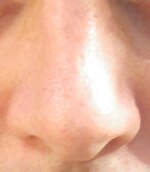Transverse nasal crease
| Transverse nasal crease | |
|---|---|
 Cartilages of the nose may become damaged along with the covering skin of the nose when nose is creased manually due to the allergic salute. Side view. | |
| Anatomical terminology |
The transverse nasal crease or groove is a line on the flesh of the ridge of the human nose located between the upper two-thirds and the lower third of the nose (slightly above the cartilage tip between the bridge and nostrils). It can occur as the result of heredity, accident, and/or the constant rubbing or wiping of the nose, commonly referred to as the allergic salute.[1][2]

Occurrence
Besides heredity and physical injury, creases on the nose are common in children and adults with chronic nasal allergies. People often intentionally or unintentionally use their hands to wipe a running nose of mucous or rub an itching nose. As the hand slides upwards across the nostrils the tip of the nose is pressed up, thus creating the crease.[3]
Appearance
The transverse nasal crease on most people will turn lighter in color than the surrounding skin and may appear white over time. This is due to the hyperpigmentation resulting from the level of melanin present in the damaged skin of the crease.[4][5] People, mainly women, have been known to use foundations, concealer, and other makeups in an attempt to hide their nasal creases. In some cases the makeup itself may settle in the crease or be absorbed onto it differently than the rest of the skin, and in this case the makeup actually makes the crease more visible and drawn to the eye.[6]
References
- ^ http://www.ncbi.nlm.nih.gov/pubmed/9470916 The transverse nasal line: an embryonic fault line
- ^ http://www.ncbi.nlm.nih.gov/pmc/articles/PMC3157813/ Atypical "allergic crease"
- ^ http://allergy-book.blogspot.com/2007/11/are-your-allergic.html Are Your Allergic?
- ^ http://www.medhelp.org/posts/Dermatology/Dark-line-at-middle-of-the-nose/show/768987 Dark line at middle of the nose.
- ^ http://www.dermatlas.com/derm/result.cfm?Diagnosis=1004497223 ALLERGIC CREASE/HYPERANDROGENISM/COMEDONES, CLOSED
- ^ http://www.youtube.com/watch?v=4jLFL8kWD9E perfect imperfections
